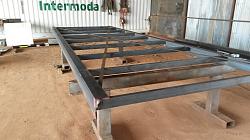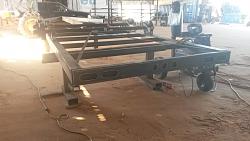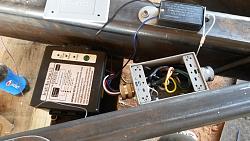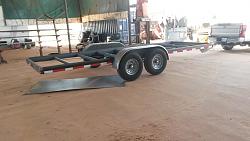My partner in a new venture we are entering into needed a trailer For the past few months I have been telling him we should just build one because he would never find a ready made trailer to suit him they would either be too heavy with things he didn't need or want or not have the capacity he wanted Finally after scouring 100's of trailer manufactures he agreed we should just build one. So I ordered a pair of 7,000 lb . axles with electric brakes on both a set of 6 leaf slipper springs 15,000 lb rated a 2 5/16" 15,000 lb rated coupler4 wheels rated for 105PSI tire pressure 5,000 lbs. and the steel to build the trailer. He searched and searched until he found USA made tires with a weight rating of 3640 lbs per tire
This is what I built for him mostly while he filled a bunch of old tires with dirt for my retaining wall behind the shop.

For the wiring I ran a 7 conductor cord through the side beam of the tongue entering via a water proof electrical box where the front amber clearance lights and the breakaway battery is connected as well all connections are soldered and double wrapped in heat shrink tubing no wires are cut. the cable continues along the frame on the right hand side to the rear light bar bumper and continues across then up the left side to the front axle then the Positive and the ground wire are reversed back to the rear axle. All wiring connections for the rear lights are done inside the rear tube split twisted soldered and protected with 2 layers of heat shrink tubing every light is grounded to the white ground wire as well as grounded to the frame the lights are all LED



 LinkBack URL
LinkBack URL About LinkBacks
About LinkBacks







 Reply With Quote
Reply With Quote



Bookmarks